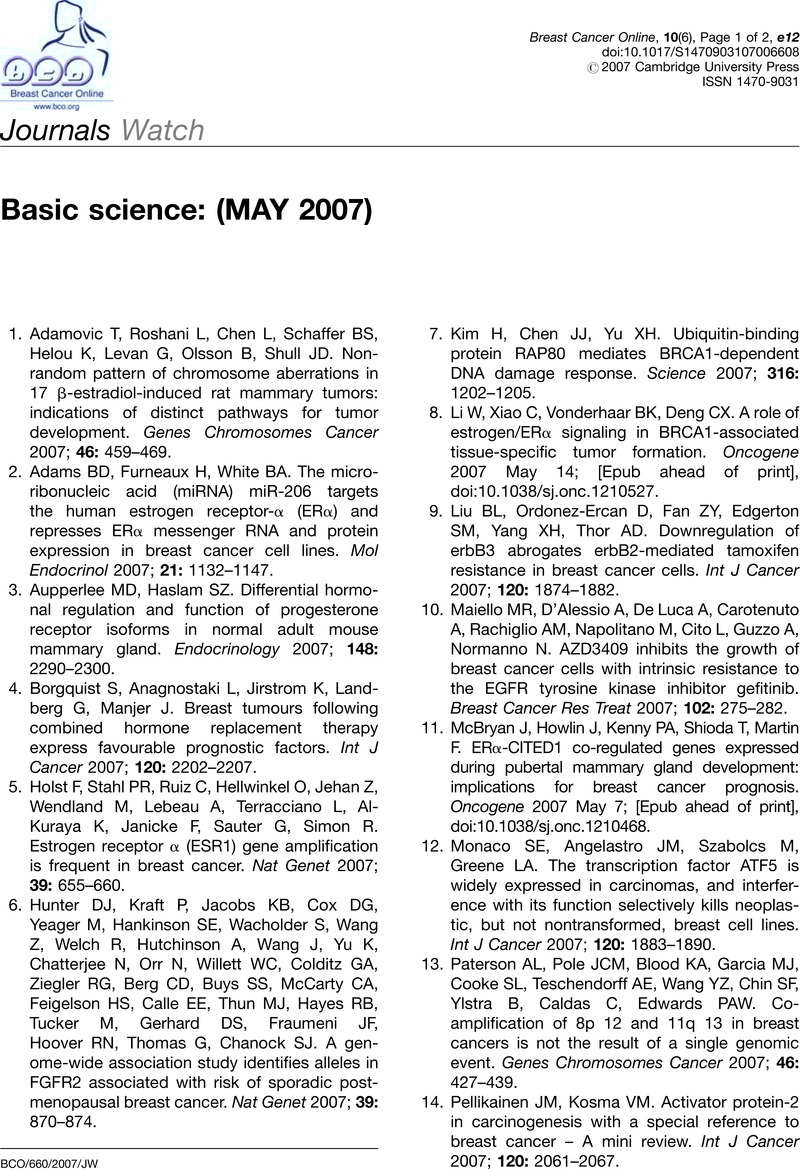No CrossRef data available.
Article contents
Basic science: (MAY 2007)
Published online by Cambridge University Press: 01 June 2007
Abstract
An abstract is not available for this content so a preview has been provided. As you have access to this content, a full PDF is available via the ‘Save PDF’ action button.

- Type
- Journal Watch
- Information
- Copyright
- Copyright © Cambridge University Press 2007
References
1.Adamovic, T, Roshani, L, Chen, L, Schaffer, BS, Helou, K, Levan, G, Olsson, B, Shull, JD. Nonrandom pattern of chromosome aberrations in 17 β-estradiol-induced rat mammary tumors: indications of distinct pathways for tumor development. Genes Chromosomes Cancer 2007; 46: 459–469.CrossRefGoogle Scholar
2.Adams, BD, Furneaux, H, White, BA. The micro-ribonucleic acid (miRNA) miR-206 targets the human estrogen receptor-α (ERα) and represses ERα messenger RNA and protein expression in breast cancer cell lines. Mol Endocrinol 2007; 21: 1132–1147.CrossRefGoogle ScholarPubMed
3.Aupperlee, MD, Haslam, SZ. Differential hormonal regulation and function of progesterone receptor isoforms in normal adult mouse mammary gland. Endocrinology 2007; 148: 2290–2300.CrossRefGoogle ScholarPubMed
4.Borgquist, S, Anagnostaki, L, Jirstrom, K, Landberg, G, Manjer, J. Breast tumours following combined hormone replacement therapy express favourable prognostic factors. Int J Cancer 2007; 120: 2202–2207.CrossRefGoogle ScholarPubMed
5.Holst, F, Stahl, PR, Ruiz, C, Hellwinkel, O, Jehan, Z, Wendland, M, Lebeau, A, Terracciano, L, Al-Kuraya, K, Janicke, F, Sauter, G, Simon, R. Estrogen receptor α (ESR1) gene amplification is frequent in breast cancer. Nat Genet 2007; 39: 655–660.CrossRefGoogle ScholarPubMed
6.Hunter, DJ, Kraft, P, Jacobs, KB, Cox, DG, Yeager, M, Hankinson, SE, Wacholder, S, Wang, Z, Welch, R, Hutchinson, A, Wang, J, Yu, K, Chatterjee, N, Orr, N, Willett, WC, Colditz, GA, Ziegler, RG, Berg, CD, Buys, SS, McCarty, CA, Feigelson, HS, Calle, EE, Thun, MJ, Hayes, RB, Tucker, M, Gerhard, DS, Fraumeni, JF, Hoover, RN, Thomas, G, Chanock, SJ. A genome-wide association study identifies alleles in FGFR2 associated with risk of sporadic postmenopausal breast cancer. Nat Genet 2007; 39: 870–874.CrossRefGoogle ScholarPubMed
7.Kim, H, Chen, JJ, Yu, XH. Ubiquitin-binding protein RAP80 mediates BRCA1-dependent DNA damage response. Science 2007; 316: 1202–1205.CrossRefGoogle ScholarPubMed
8.Li, W, Xiao, C, Vonderhaar, BK, Deng, CX. A role of estrogen/ERα signaling in BRCA1-associated tissue-specific tumor formation. Oncogene 2007 May 14; [Epub ahead of print], doi:10.1038/sj.onc.1210527.CrossRefGoogle ScholarPubMed
9.Liu, BL, Ordonez-Ercan, D, Fan, ZY, Edgerton, SM, Yang, XH, Thor, AD. Downregulation of erbB3 abrogates erbB2-mediated tamoxifen resistance in breast cancer cells. Int J Cancer 2007; 120: 1874–1882.CrossRefGoogle ScholarPubMed
10.Maiello, MR, D’Alessio, A, De Luca, A, Carotenuto, A, Rachiglio, AM, Napolitano, M, Cito, L, Guzzo, A, Normanno, N. AZD3409 inhibits the growth of breast cancer cells with intrinsic resistance to the EGFR tyrosine kinase inhibitor gefitinib. Breast Cancer Res Treat 2007; 102: 275–282.CrossRefGoogle Scholar
11.McBryan, J, Howlin, J, Kenny, PA, Shioda, T, Martin, F. ERα-CITED1 co-regulated genes expressed during pubertal mammary gland development: implications for breast cancer prognosis. Oncogene 2007 May 7; [Epub ahead of print], doi:10.1038/sj.onc.1210468.CrossRefGoogle ScholarPubMed
12.Monaco, SE, Angelastro, JM, Szabolcs, M, Greene, LA. The transcription factor ATF5 is widely expressed in carcinomas, and interference with its function selectively kills neoplastic, but not nontransformed, breast cell lines. Int J Cancer 2007; 120: 1883–1890.CrossRefGoogle Scholar
13.Paterson, AL, Pole, JCM, Blood, KA, Garcia, MJ, Cooke, SL, Teschendorff, AE, Wang, YZ, Chin, SF, Ylstra, B, Caldas, C, Edwards, PAW. Co-amplification of 8p 12 and 11q 13 in breast cancers is not the result of a single genomic event. Genes Chromosomes Cancer 2007; 46: 427–439.CrossRefGoogle Scholar
14.Pellikainen, JM, Kosma, VM. Activator protein-2 in carcinogenesis with a special reference to breast cancer – A mini review. Int J Cancer 2007; 120: 2061–2067.CrossRefGoogle ScholarPubMed
15.Ross, JS, Symmans, WF, Pusztai, L, Fiortobagyi, GN. Standardizing slide-based assays in breast cancer: hormone receptors, HER2, and sentinel lymph nodes. Clin Cancer Res 2007; 13: 2831–2835.CrossRefGoogle ScholarPubMed
16.Sabnis, G, Goloubeva, O, Jelovac, D, Schayowitz, A, Brodie, A. Inhibition of the phosphatidylinositol 3-kinase/Akt pathway improves response of long-term estrogen-deprived breast cancer xenografts to antiestrogens. Clin Cancer Res 2007; 13: 2751–2757.CrossRefGoogle ScholarPubMed
17.Sirvent, A, Boureux, A, Simon, V, Leroy, C, Roche, S. The tyrosine kinase Abl is required for Src-transforming activity in mouse fibroblasts and human breast cancer cells. Oncogene 2007 May 28; [Epub ahead of print], doi:10.1038/sj.onc.1210543.CrossRefGoogle ScholarPubMed
18.Sobhian, B, Shao, GZ, Lilli, DR, Culhane, AC, Moreau, LA, Xia, B, Livingston, DM, Greenberg, RA. RAP80 targets BRCA1 to specific ubiquitin structures at DNA damage sites. Science 2007; 316: 1198–1202.CrossRefGoogle ScholarPubMed
19.Stacey, SN, Manolescu, A, Sulem, P, Rafnar, T, Gudmundsson, J, Gudjonsson, SA, Masson, G, Jakobsdottir, M, Thorlacius, S, Helgason, A, Aben, KK, Strobbe, LJ, Albers-Akkers, MT, Swinkels, DW, Henderson, BE, Kolonel, LN, Le Marchand, L, Millastre, E, Andres, R, Godino, J, Garcia-Prats, MD, Polo, E, Tres, A, Mouy, M, Saemundsdottir, J, Backman, VM, Gudmundsson, L, Kristjansson, K, Bergthorsson, JT, Kostic, J, Frigge, ML, Geller, F, Gudbjartsson, D, Sigurdsson, H, Jonsdottir, T, Hrafnkelsson, J, Johannsson, J, Sveinsson, T, Myrdal, G, Grimsson, HN, Jonsson, T, von Holst, S, Werelius, B, Margolin, S, Lindblom, A, Mayordomo, JI, Haiman, CA, Kiemeney, LA, Johannsson, OT, Gulcher, JR, Thorsteinsdottir, U, Kong, A, Stefansson, K. Common variants on chromosomes 2q35 and 16q12 confer susceptibility to estrogen receptor-positive breast cancer. Nat Genet 2007; 39: 865–869.CrossRefGoogle ScholarPubMed
20.Ursini-Siegel, J, Schade, B, Muller, WJ, Cardiff, RD. Timeline – insights from transgenic mouse models of ERBB2-induced breast cancer. Nat Rev Cancer 2007; 7: 389–397.CrossRefGoogle Scholar
21.Wang, X, Liu, L, Montagna, C, Ried, T, Deng, CX. Haploinsufficiency of Parp1 accelerates Brca1-associated centrosome amplification, telomere shortening, genetic instability, apoptosis, and embryonic lethality. Cell Death Differ 2007; 14: 924–931.CrossRefGoogle ScholarPubMed




